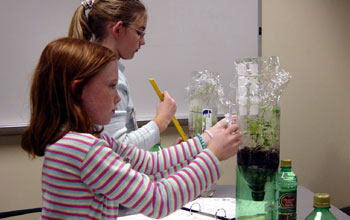Multimedia Gallery
BUGS Program (Image 2)
BUGS Program (Image 2)
Girls receive hands-on opportunities to engage in science activities through BUGS--Bringing Up Girls in Science Program. The program was run by associate professor Tandra Tyler-Wood of the University of North Texas (UNT) in Denton. [One of 7 related images. See Next Image.]
More about this Image
In an effort to encourage more girls to study science, professor Tandra Tyler-Wood of the University of North Texas (UNT) in Denton, launched a science-themed, after-school program for girls in the local school district: BUGS--Bringing Up Girls in Science.
In the first year, Tyler-Wood matched 30 fourth- and fifth-grade girls with teenage mentors recruited from the Texas Academy for Mathematics and Science (TAMS), a residential program that gives talented high school girls an opportunity to simultaneously earn their high school diplomas and finish two years of college at UNT. The student pairs met throughout the year to explore the scientific method through a series of hands-on experiments in an outdoor laboratory. The goal was to improve the younger girls' critical thinking skills but also to hold their interest.
Together, the students explored the properties of soil, the oceans and the sun. They identified the physical properties of matter, learned how organisms survive and adapt, and studied magnetism and conductivity. To learn about ecology and animal life cycles, they raised colonies of meal worms and formed hypotheses about their behavior. At the end of the year, the mentoring teams presented the results of their work to parents, teachers and friends.
In the following two years, the high school students were introduced to mentors of their own--science and engineering majors from the American Association of University Women. The college women offered advice on everything from career choices to college life.
At the end of the three-year program, Tyler-Wood concluded that the partnerships had in fact encouraged an interest in science among the younger students. Her research team conducted interviews with each participant before, during and after her participation in the project. Using standardized science assessment tests, the researchers followed the student's math and science skill levels. The researchers also tested a group of fourth- and fifth-grade girls who weren't involved in the BUGS program. Compared to this "contrast group," BUGS students showed a marked increase in enthusiasm, confidence and science skills at the end of the school year.
Tyler-Wood hopes to continue the BUGS project beyond its three-year demonstration phase and also, to export what she has learned from the project to the broader education community, both nationally and internationally.
The BUGS Program was supported by a National Science Foundation grant from the Division of Human Resource Development (HRD 01-14917) (Date of Image: October 2003)
Credit: Mark Mortensen, University of North Texas
Images and other media in the National Science Foundation Multimedia Gallery are available for use in print and electronic material by NSF employees, members of the media, university staff, teachers and the general public. All media in the gallery are intended for personal, educational and nonprofit/non-commercial use only.
Images credited to the National Science Foundation, a federal agency, are in the public domain. The images were created by employees of the United States Government as part of their official duties or prepared by contractors as "works for hire" for NSF. You may freely use NSF-credited images and, at your discretion, credit NSF with a "Courtesy: National Science Foundation" notation.
Additional information about general usage can be found in Conditions.
Also Available:
Download the high-resolution JPG version of the image. (958 KB)
Use your mouse to right-click (Mac users may need to Ctrl-click) the link above and choose the option that will save the file or target to your computer.



